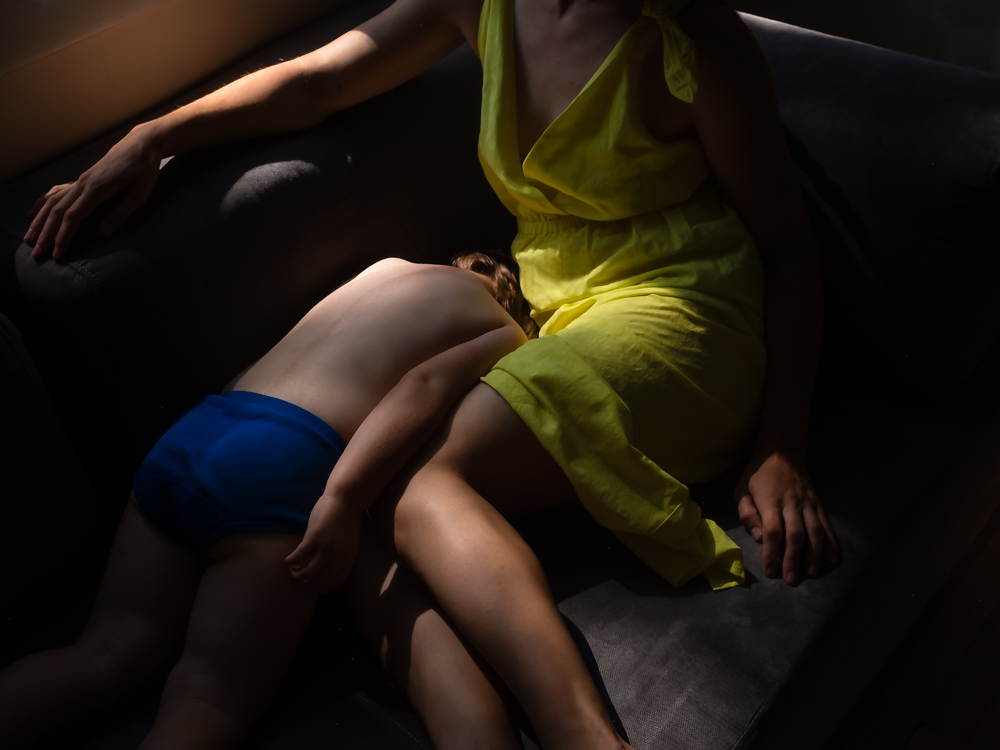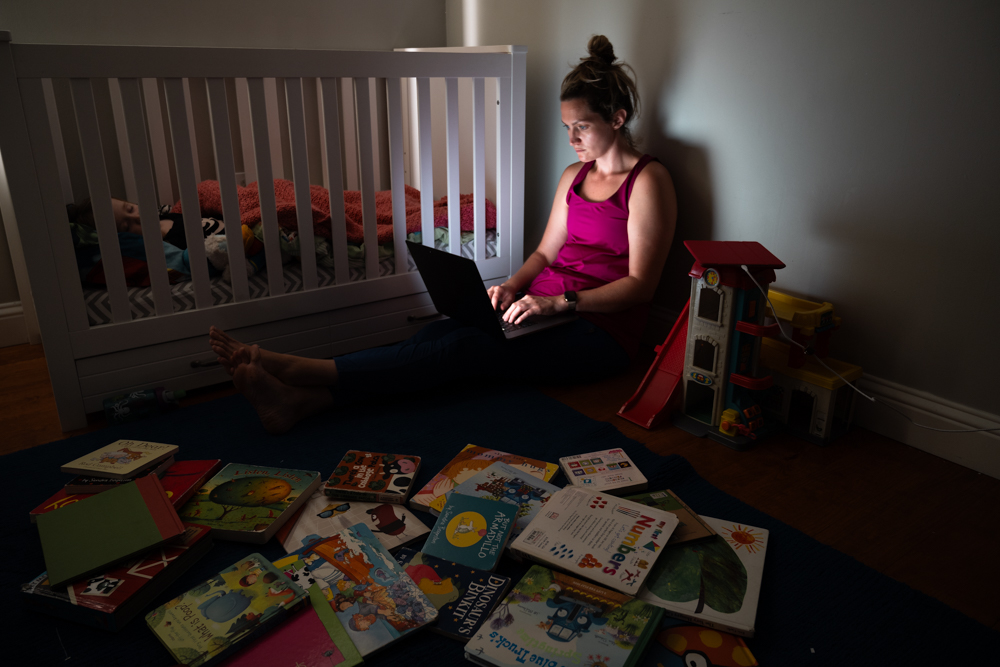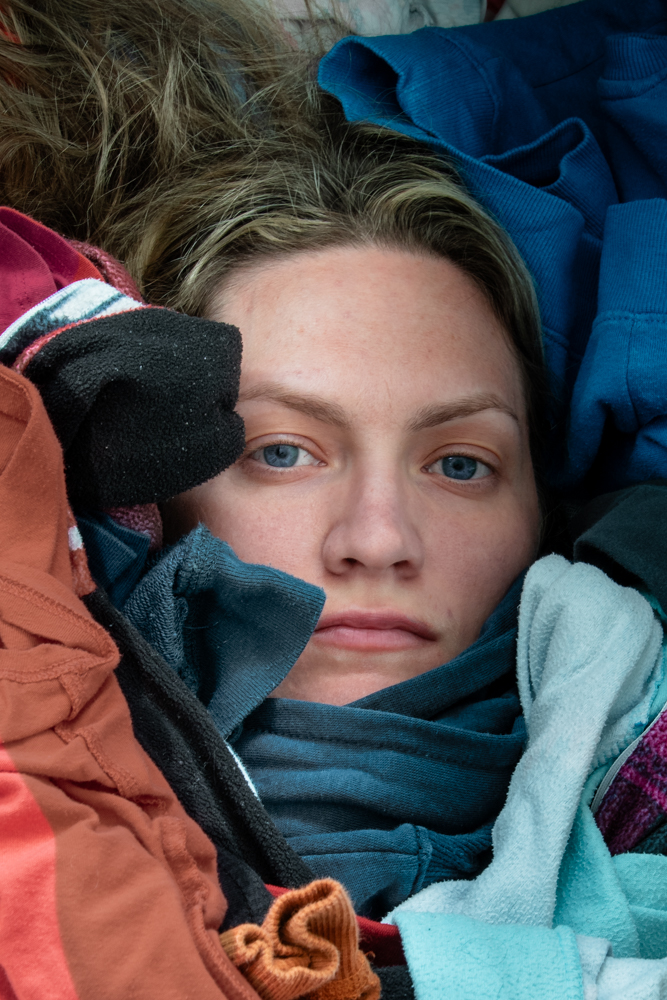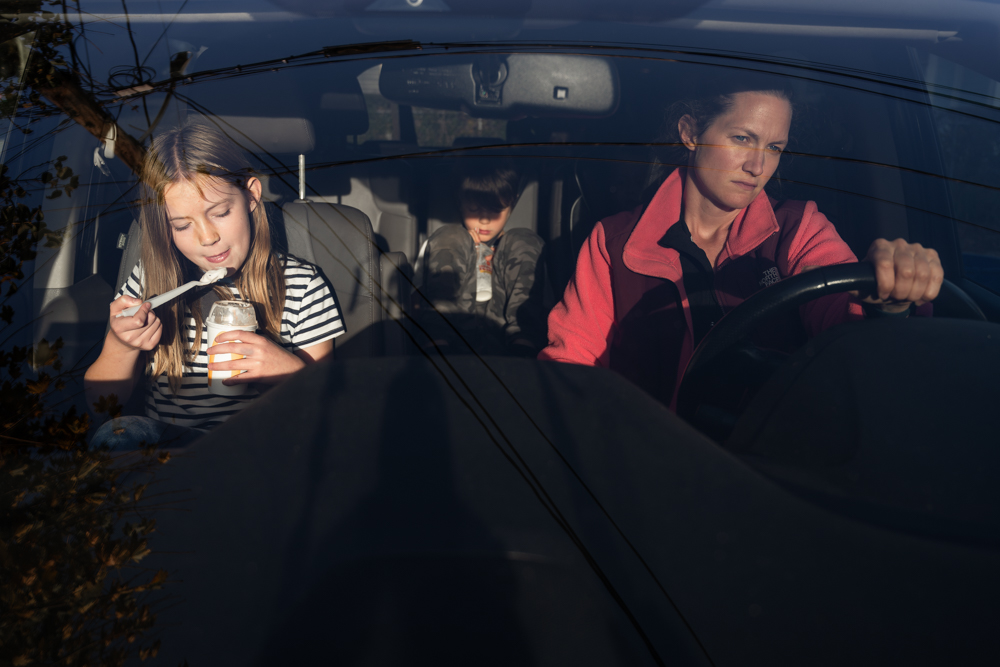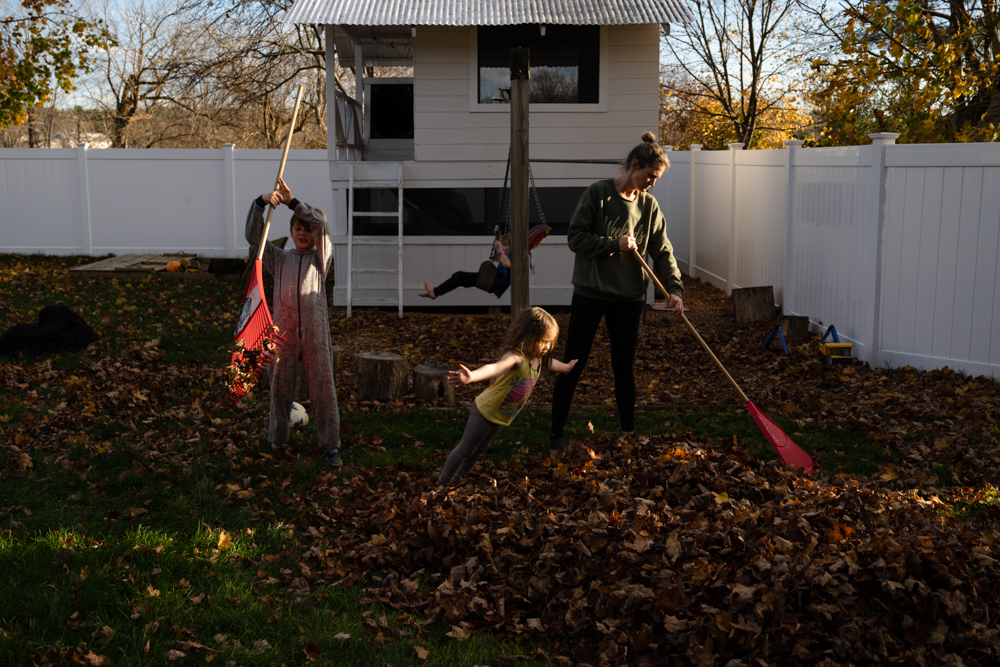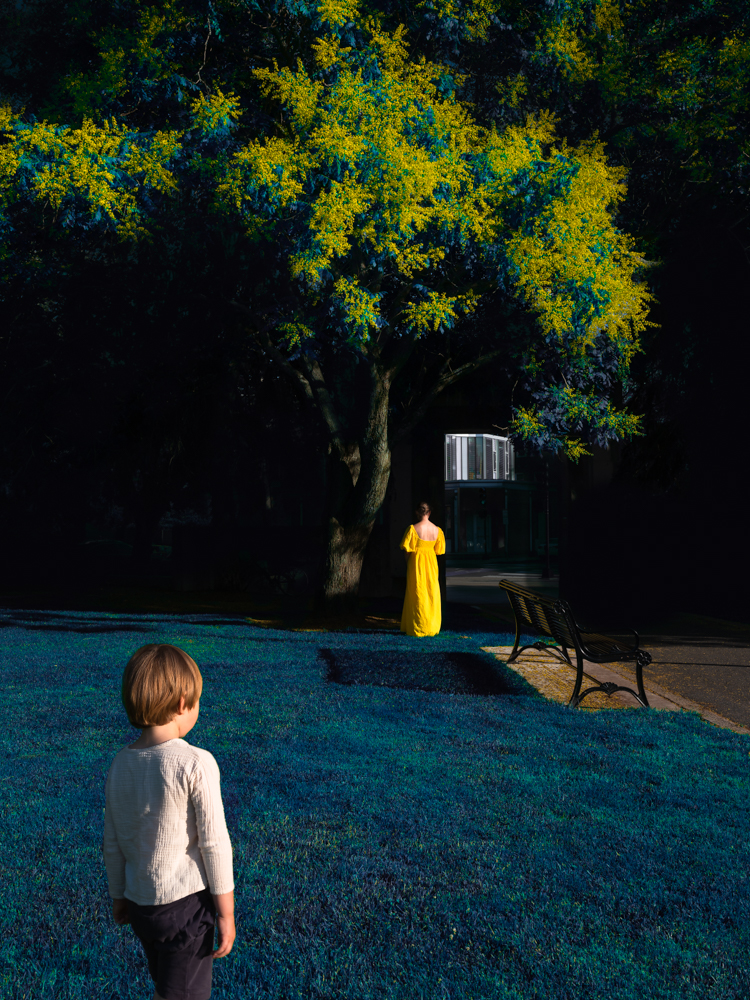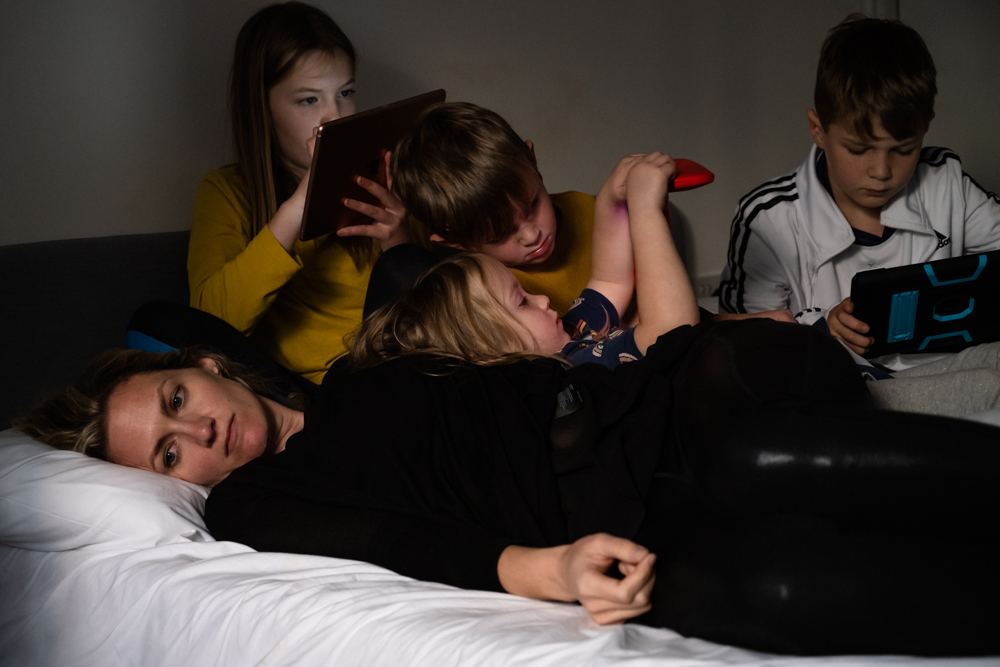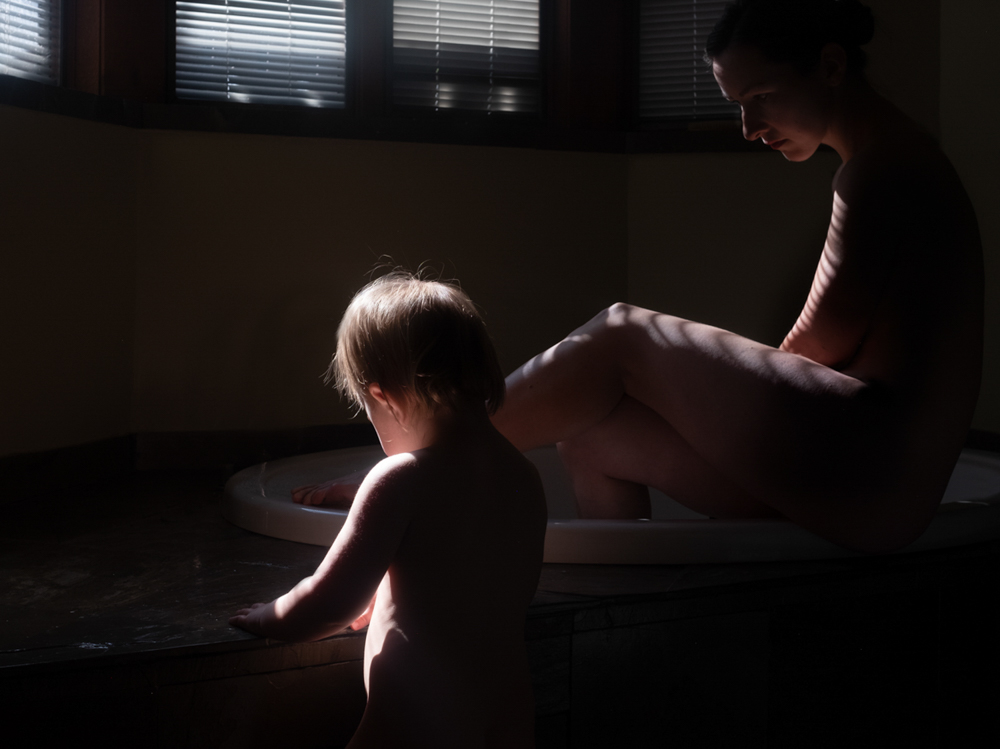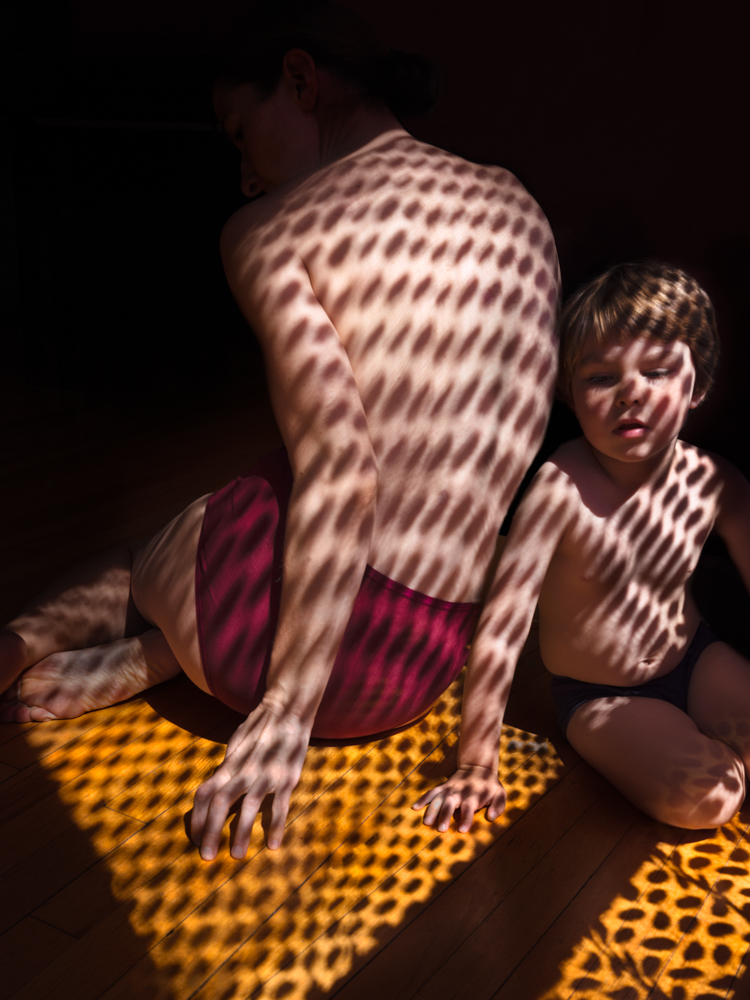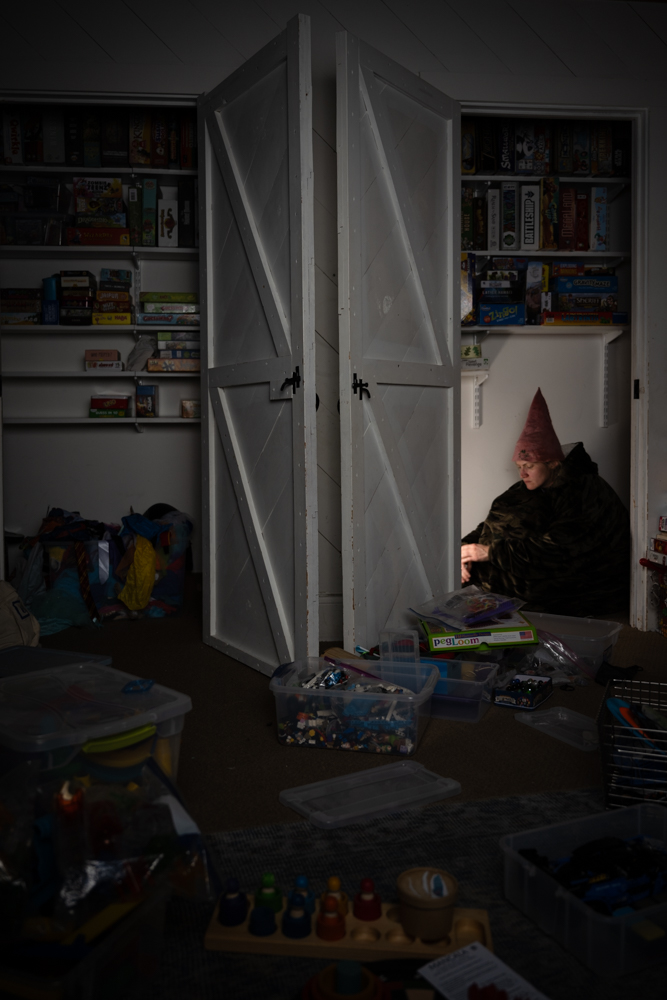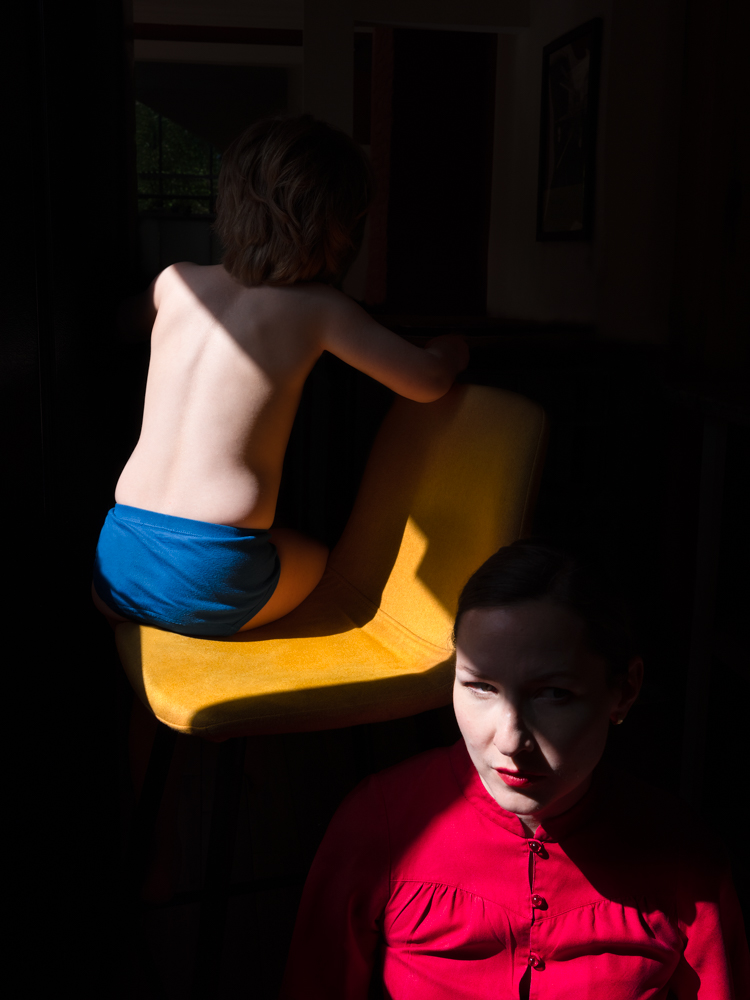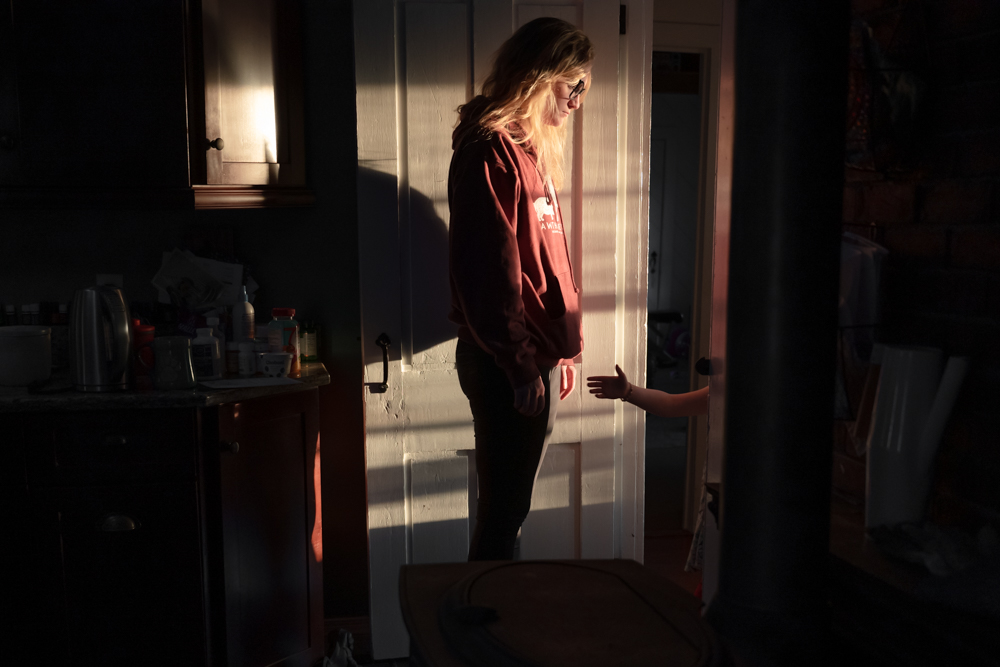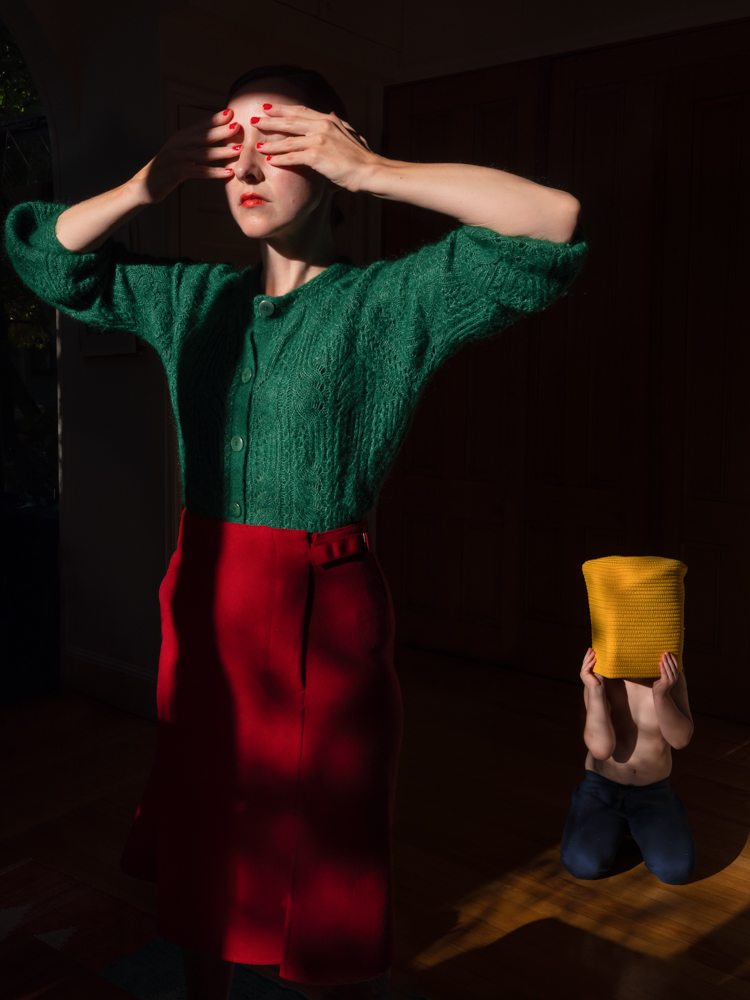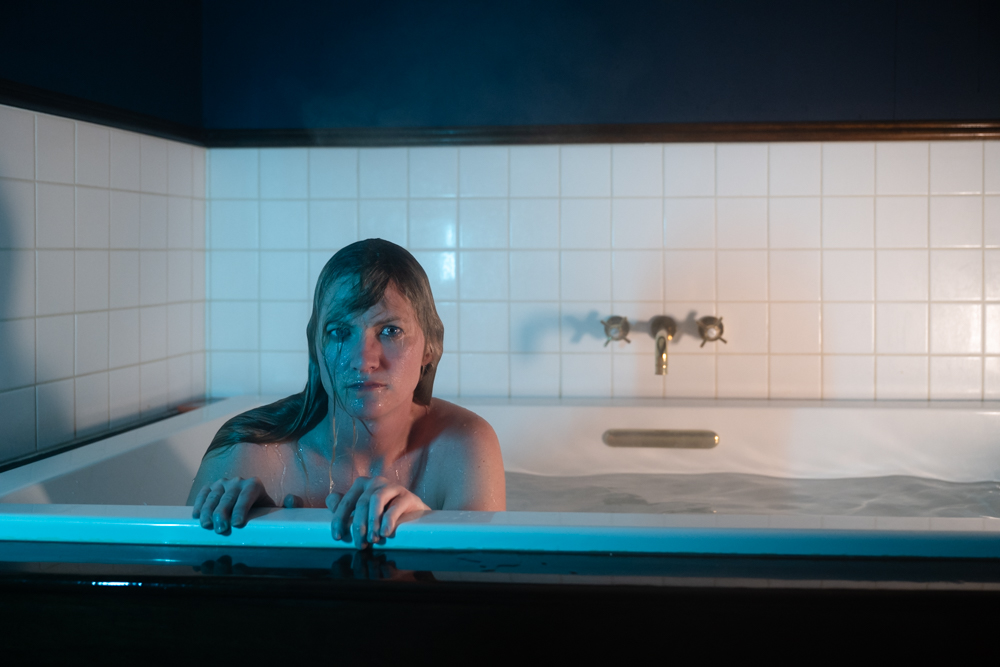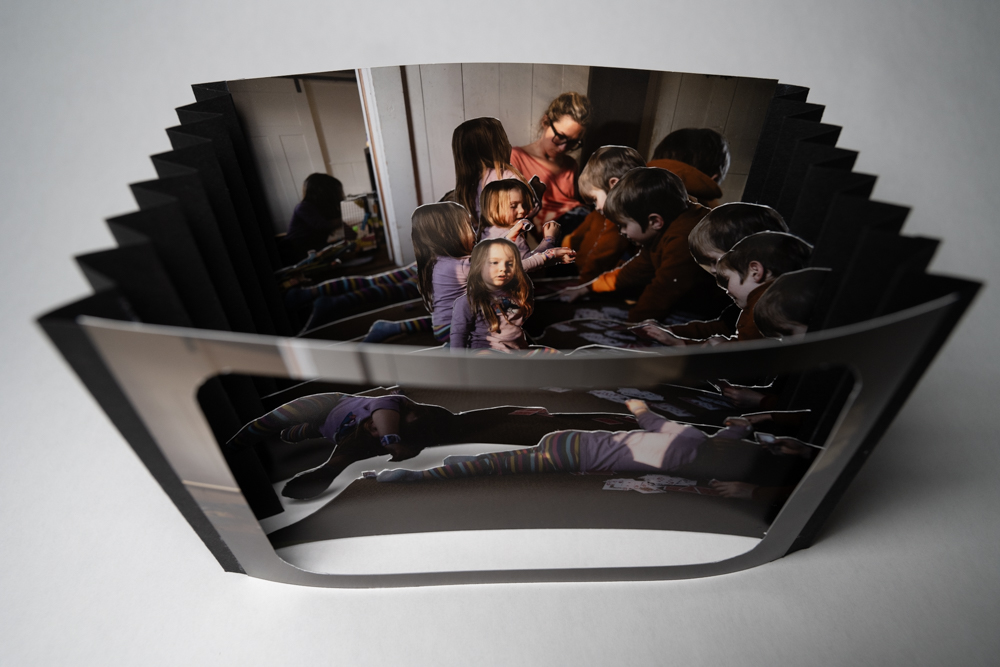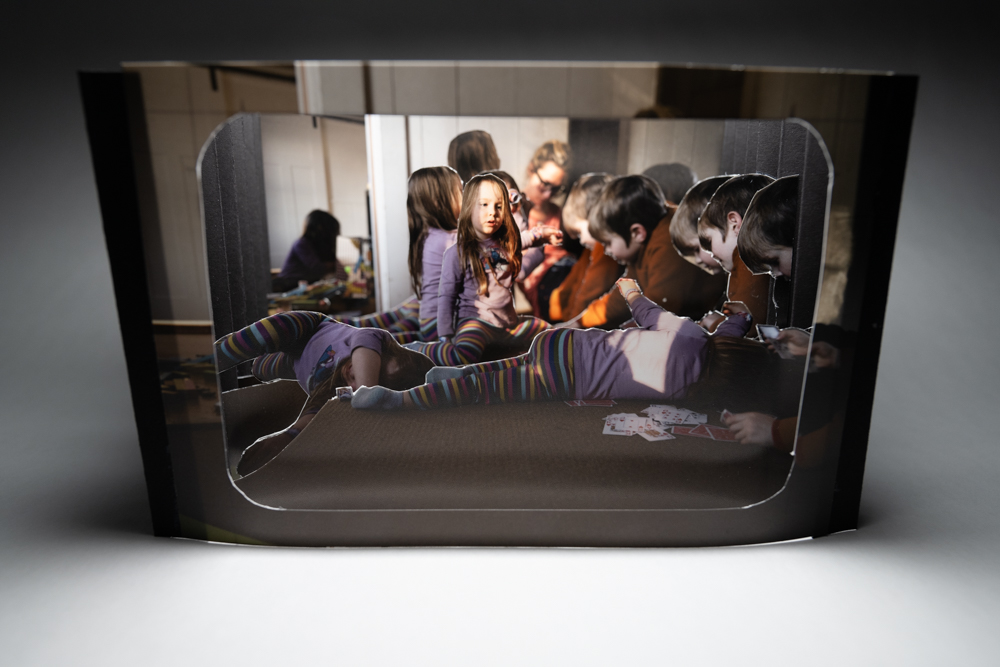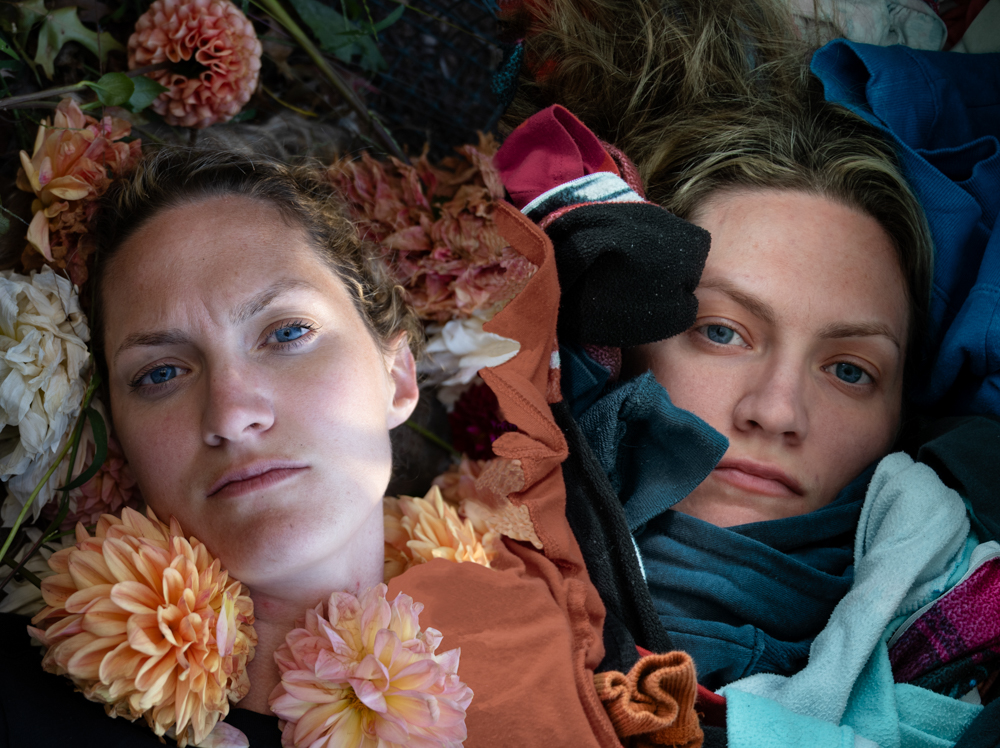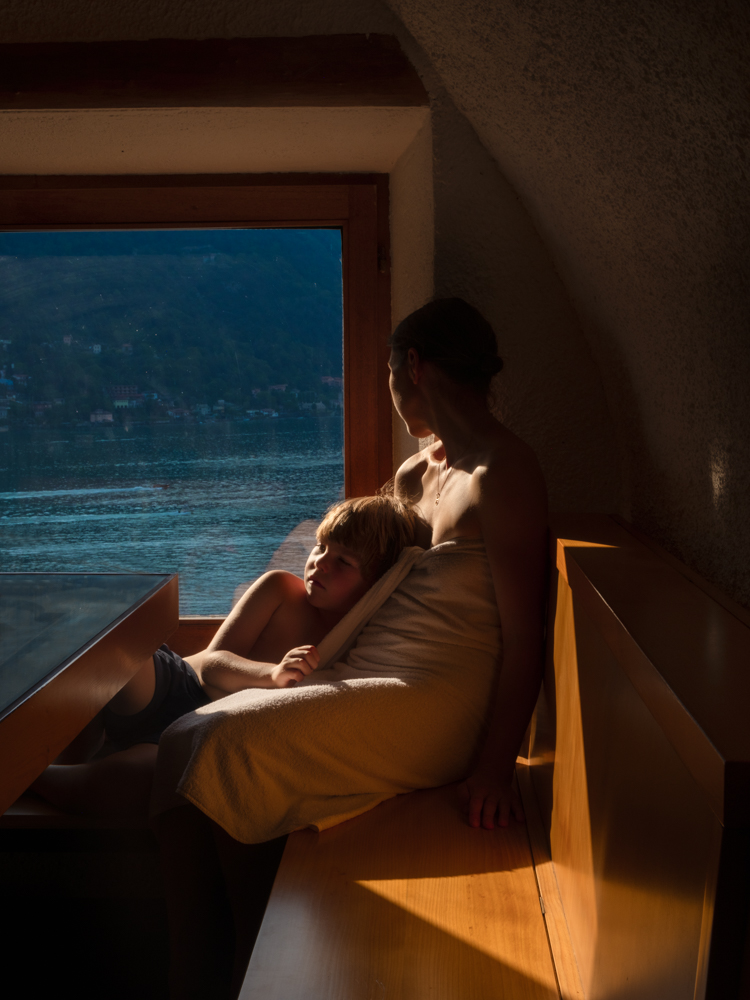Anastasia Sierra and Carrie Usmar: Talking Motherhood
Carrie Usmar and Anastasia Sierra use photography to investigate the complexity of motherhood. Both artists highlight the unseen challenges of motherhood while embracing the intimate and tender moments of raising children, using very different formal approaches. In the conversation that follows, the artists discuss making work on motherhood and being artist mothers.
Anastasia Sierra (b.1983) is a Russian – born American photographer and artist based in Cambridge, MA. Her work explores the transcendence of motherhood, womanhood, and our connection to the natural world. Sierra has exhibited in the U.S. and internationally, most recent exhibitions include the Vermont Center of Photography, Kathryn Schulz Gallery in Cambridge, MA, and Soho Gallery in New York. Her work is included in Eyemama: Poetic Truths of Motherhood by Karnie Arieli, published by teNeues Verlag. She holds a BA in Linguistics and a Photography Certificate from Boston University.
Follow Anastasia on Instagram: @anastasiasierra
Carrie Usmar (b. 1985) is Rhode Island based visual artist whose practice re-examines the family album. Utilizing a documentary approach, Usmar explores the complexity of womanhood and the tension and ambivalence within domesticity. Her narrative projects are devoted to highlighting the psychological and unseen, the isolation and challenges of motherhood, and the humorous and poignant moments of raising a family.
Usmar received a BFA from University of Rhode Island with a focus in photography and filmmaking. She has exhibited at numerous institutions across the U.S., including the Rhode Island Center For Photographic Arts, Newport Art Museum, Hera Gallery, The Griffin Museum and The Curated Fridge. Her work has been published on The Luupe and Lenscratch. She was selected for a residency at Garrett On The Green in upstate NY and was invited to attend the Eddie Adams Workshop XXXVI. Usmar is also a top 200 finalist for 2022 Critical Mass.
Follow Carrie on Instagram: @carrieusmar
Anastasia Sierra: Carrie, I first came across your work around the same time as I started getting deeper into my own project about motherhood. I was struck by the honesty and humor in your images. I feel like on the surface you are showing all the things that I am trying to escape in my work (I push out the chaos into the shadows), but on the emotional level, we are talking about the same things. Tell me, how did you start photographing your motherhood experience, and how did you arrive at your way of seeing – raw, truthful and at times humorous?
Carrie Usmar: After studying photography and film in college, I fell out of doing project based work. I tried to make a career doing weddings and family photography and got burnt out.
A few years after I became a mother I started writing. I was going through a lot and a friend gave me a notebook and asked if I considered writing down my thoughts. I never liked journaling but in time I learned that writing helps me process experiences. The only time I could concentrate on writing was when my family was asleep. So I’d wake up at 4am, drink tea, eat chocolate, and write. I’d have to take naps with my little ones to survive but it was worth it. I thought my dream was to publish a memoir but I grew frustrated. I was succumbing to my perfectionist tendencies, and it became challenging to write
This was right around the time I received a copy of our tax returns and my occupation was listed as “houseperson”. The reduction of my role as a full-time caregiver to a such an antiquated term felt undermining. Around the same time, I was looking for a job and building a resume. I wasn’t sure what to put for the gap in employment so I googled, “Should I put stay at home mom on my resume?”. I found studies that said not to because employers view stay at home parents as less reliable and less committed than unemployed people. Anger and sadness consumed me. How is it that everything I’ve learned and achieved while being at home with my kids has a negative impact on me in the work world? I tried many mornings to write my feelings on this but I kept getting stuck.
One morning, in a fit of anger, I set up my tripod and camera and covered myself in laundry and made a self portrait. I titled the image “Laundry Specialist” and that was the start of my ongoing series “Resume Of A Stay At Home Mom”.
For the past few years, I’ve photographed ordinary mothering moments that show the joy, solitude, and sacrifice I’ve experienced as a stay at home mom. I chose a title for each image that corresponds to a skill on a resume. Creating this project made me feel seen and valued in an often invisible and thankless role and I continue to advocate for the recognition of care giving as a profound and valuable endeavor.
I started the series doing more formal images and trying to orchestrate my children to be where I wanted them but found that I was more drawn to the raw and vulnerable images that came later when I stopped trying to control the situation and let everyone do whatever they wanted. I am now at a point where I set my camera up at an angle and lit in a way I like but I don’t give any direction to my kids. It’s difficult and freeing at the same time. Sometimes the images aren’t great, but I know I’ll see them differently someday. I’ll be glad when I see the everyday me doing everyday things like driving everyone to sports or cleaning up the never ending messes and my kids will see the version of me they remember most.
Carrie Usmar: When I first saw your work, I was enamored with the color, contrast, and textures in your photos. Your images stuck with me. How did you become interested in photography and specifically in photographing motherhood?
Anastasia Sierra: It was somewhat accidental. My first career was in translation, and I signed up for a language course at an adult education center but it got canceled, and I ended up switching to photography. The job I had then was not especially creative, and photography became the place to dream and play for me. I have thought of myself as a photographer ever since.
My first photography obsession was fashion. I was fascinated with the genre’s potential for creating fictional worlds that provide a ready, if ephemeral, escape from day-to-day. For a while I was working towards a career in fashion photography, while supporting myself shooting anything from events to editorial portraits. I was so high on the freshness of getting paid to do what I love, I would shoot anything for anyone. It’s not easy to stay afloat as a freelancer, so most of my energy went into testing the waters in new areas of commercial and editorial photography, and I didn’t have space to think about what I wanted from my work, or what it was about, just assumed it was making it in fashion in some way.
Becoming a mother has slowed me down, and also put the missing piece of the puzzle right in front of me: while fashion images are fun to make and to look at, I’ve always struggled to answer why I needed to make them. When I started making work about motherhood, I realized I could use the formal elements of fashion photography that I enjoy to create images that tell stories that are meaningful to me.
Anastasia Sierra: I love the image of you lying on the bed with your kids on ipads. Tell me about your process – how do you come up with ideas for images? And how do you manage to round up everyone for a shoot, and agree on the direction? How do your children see your work? Do you get pushed back on, and how do you deal with it?
Carrie Usmar: My images are not staged and yet they are staged. Sometimes I want to capture an experience or emotion. I remember I was feeling particularly sad on the day I captured the ipad photo. We were in London and my husband was working a long day. I was afraid to take them all out of the hotel by myself. My mind was telling me I was being dumb and am not a fun mom. Then I saw this beautiful natural light on our room and asked the kids to come do Ipad on my bed. They were happy to move and hardly knew what I was doing. I felt better after taking that image and was able to get out of my head.
Most of the time, I put my camera on a tripod and take a photo every 3-4 seconds for 75 frames, then I check the camera. It can be tedious but works for me. Occasionally I will collaborate with my children. I might ask them to sit in a spot, or let me braid their hair for a photo and the older two might come up with ideas for more images. They don’t mind being in the photographs. My older two understand my project and are proud to be a part of it. My younger two don’t quite understand yet. My son who is 7 knows I appreciate the light coming from the windows and will often ask me to take his picture in it. My youngest is hit or miss. Most of the time she will not follow any kind of direction which makes her special since she is never acting in the images. All of them love to be the photographer and take pictures of me. Sometimes I don’t feel like setting up the tripod and I give them the camera. Many of the photos end up crooked and out of focus but they love it and there is beauty in those experiences too.
Carrie Usmar: Unlike mine, your images appear to be formal and somewhat staged. I realize it’s probably hard to make a toddler sit in one spot or turn a certain way but the light, color and shadow seem intentional. Can you share your process for making these images? How was it working with your son?
Anastasia Sierra: It always starts with the light for me. While I took some self-portraits with my son when he was a baby, the project really started about a year later, early in the pandemic, when he walked into a shaft of light streaming through our windows, at 5-30 AM. After months of bad nights I wasn’t particularly happy to be alive, let alone awake, but his blond toddler hair looked so beautiful in that light, I wanted to freeze time. But the sleep deprived me was still there too, in the shadows. I wanted to make pictures about that, using that light.
I usually block off the times when my son is home and the forecast is sunny. Then I think about potential color/clothing combinations. I build little sets around the areas where the light is interesting, and work on the framing and composition, first with just me in the frame. And then the negotiations begin! I am not a present parent when I make pictures. And it often takes me a while to figure out the framing, poses and what works in terms of colors. So it can get annoying for my son. I often have to come up with playful ways of getting him to collaborate. And when it works, it’s magic! Very often I don’t get any photographs I want to keep, or have to stop shooting just as I begin to feel like I am getting somewhere. But it’s important not to push it – we can always try again later.
Making pictures together has been a great experience for us. And, I noticed that once I’ve done my work for the day, I have more room for everyone else’s needs. Making space for my art has made me a better mother and a better partner.
In many ways my process is similar to what I do with my portrait and fashion work: I look for suitable locations with strong light, and plan the wardrobe. The big, and positive, change that came with this project is that I no longer look at outside references or try to conceptualize the images beforehand. I used to make mood boards with poses and gestures to try out, and I haven’t done it in years. Once I’ve set up the “stage”, I work with what’s there, and I’ve been really enjoying it.
Carrie Usmar: I find self-portraits to be so difficult sometimes. The back and forth from being in the scene to checking the camera. My remote breaks or the app isn’t working. Why do you take self portraits?
Anastasia Sierra: If I had unlimited access to someone with a kid and their willingness to be photographed as I please, I think I’d prefer that to self portraits! But schedules are complicated, and working with other people adds another layer of complexity to the process on many levels. It would be hard to shoot as often and have enough room to experiment if I was dependent on that. I am happy to not have this kind of pressure with this work.
The project in itself is not about us or our lives. It’s about how certain things about motherhood feel: beautiful, warm, soft, playful and also sometimes sad, lonely, and maddening. I am, however, very grateful to have these images of us together, our bodies touching in the warm light, as we move through these years.
Anastasia Sierra: I see so many familiar moments in your work. This feeling of being trapped in the chaos – tidying up the floor only to have food all over it within minutes and having to clean it up again without showing frustration, while being pulled in a million other directions already.
And then I see the images of you alone, and feel immediate relief. I’ve grown to love solo domestic moments over the last few years. Are solo self portraits a new direction for you?
Carrie Usmar: Solo self portraits are kind of new and kind of not. When I was in college, I took a lot of self-portraits. I did a whole series on my obsession with Diet Coke. But I stopped taking them so the portraits I am making now are new to me. I love capturing the honest parts of who I am at this moment in time, carrying laundry down the steps, washing dishes, being left alone holding gingerbread houses together while they dry. I know that’s super specific but sometimes I wish it were easier to capture some of the situations I am in because many are so funny. And I know I am not alone, some other poor mother didn’t get the memo to superglue the houses and she was probably holding them together too.
I capture these self portraits because I want a memento of this time and I want to remember the little things. Below is a photo I took a few days after the new year. On January 1st, 2024 I decided to clean out our playroom closet. I was feeling the “New year, new me, lets purge..” A few days later, I thought, “I am so over this.” I found my son’s gnome hat and laughed wondering what someone would think if they found me in the closet with the gnome hat on. And this lead to capturing the moment, playing with light, and not cleaning. Now when I look at the image I smile and think “This is my life.” I am always motivated at the start of January and September to begin a new routine and make changes, but this image is my reality, I don’t often finish projects and I get distracted. I am who I am and I am enough.
Carrie Usmar: How hard has it been to be a mother and an artist and who do you look to for inspiration?
Anastasia Sierra: Motherhood has shaped me as an artist: it me a subject for my work, and the freedom and space to experiment and make mistakes without external pressure. Before becoming a mother, I was looking for source material elsewhere, there was this very defined border between my home life and my work. Now whenever I put myself in the “seeing mode”, I see a lot of beauty and magic in what I used to think of as mundane experiences. I’ve grown to appreciate my daily life more, I don’t try to run away from it.
What I find has been hard is the business side of things: it is so important to reach out, meet people in person, go to other artists’ openings, and it has been hard to fit that into my schedule without feeling guilty: my husband has a busy job, and evenings away from home often mean more stress for my family. And then, if I bring my son along, I’m never a hundred percent with anyone. Being able to have it all is a lie, but still something to work towards!
I wish I had come across my inspirations earlier in my motherhood experience, a lot of them happened retroactively! I am glad there is a growing conversation about motherhood in the arts and in our society in general. A big one for me lately was the novel “Nightbitch” by Rachel Yoder. My internal experience was very close to that of the protagonist. Luckily, I’ve managed to avoid turning into a dog, but I’ve come close! I wish I’d known about this book when it first came out: a lot of my mother friends had established careers and went back to full time jobs a few months after giving birth. They had other challenges, but I don’t think they experienced the same identity shift as I did, so the early years felt pretty isolating.
I think acknowledging and normalizing our difficult experiences, not just our triumphs, is so important. Good art has the capacity for making you feel less alone and pulling you out of the darkness.
Anastasia Sierra: How do you balance mothering and making art?
Carrie Usmar: I don’t balance both well but I do my best. I feel like there is always something I want to get done with my art. Applying for this show, creating a newsletter, writing an Instagram post, sending emails, editing work for an upcoming deadline, and the list keeps going. Sometimes I find it hard to be present with my kids when I have a deadline looming. I just want to get something done but I am trapped playing Magnatiles or painting nails till bedtime.
At the same time, I get overwhelmed with the logistics of parenting. At the end of this school year, I had school events most nights, and extra stuff to remember beyond the everyday. Band, soccer play-offs, dance recitals, field-trips, pre-k graduation, karate belt promotion.. It can be challenging to create when my mind is so full. I try to continue to take pictures and remind myself this season is short. But I have to constantly check my thoughts, that I’m not beating myself up for being imperfect. It’s a delicate balance and a worthy one.
Carrie Usmar: I have a really hard time when I’m stuck in the midst of a project that isn’t coming together. I question everything and want to quit. I am curious, what do you do when you are feeling stuck creatively?
Anastasia Sierra: I keep making work. The big shift in my process was to allow myself to make bad pictures every now and again (or, more like, a lot of them, all the time!). Of course there is always some disappointment when you spend all this time on a shoot and have nothing to show for it. My answer to this is to shoot more often and let failure be a regular part of my process, and not this big upsetting event that throws me off balance. Every shoot gets me closer to getting an image I want to keep, to understanding what I am looking for.
I am working on a new project about water and women now, and absolutely love the process. Visually, it’s less controlled than the project with my son. I’m still working out where it’s going, and the process is incredibly fun. One of my favorite shoots was when I was trying to capture two women smashing ice at Walden pond. The light changed too quickly, and we couldn’t stay in the icy water for very long, so I didn’t get an image I love, but the energy of that shoot is still with me and makes me look forward to next winter.
Carrie Usmar: I love that, “Shoot more often, let failure be a part of your process.” I often question why I do this? Why be vulnerable and make work about my experiences? Is there a purpose that drives your work?
Anastasia Sierra: Photography helps me pay closer attention to the world, it’s a way to honor my experiences, and not sleepwalk through life. It can help to turn something difficult or painful into something beautiful. And, it makes me happy to think that the resulting images might touch someone else in some way: make them feel less alone in what they are going through, bring back a warm memory, or inspire them to put on a fancy dress and go run around a playground with their kid. Or wash the dishes. And maybe even make some art about it?
Anastasia Sierra: Since you began the “Resume” series, you have had success and even achieved some big goals. Can you tell me more about that?
Carrie Usmar: Well it has been a challenge and success doesn’t come without a lot of rejection. But I am passionate about my project and work hard at putting it out there. Last year I applied to Eddie Adams Workshop and was chosen to attend. Without going into too much detail, I was given an assignment to photograph a cannabis farm in Upstate, NY. I had two sessions at the cannabis farm and only 600 frames each day. It was challenging and rewarding to learn from the team leaders and watch them go through my images. I listened to many inspiring speakers and had portfolio reviews two of the evenings. I hadn’t experienced a portfolio review so I did a lot of research and preparation. I was nervous that the reviews began at 9:30pm because generally I’m in bed by then but my adrenaline was high and I had a successful and fun experience. One thing I know the reviewers appreciated was that I had physical prints. Not only did I get to see my photos printed for the first time but so many people would come and ask to see my work because my prints were accessible.
One of my goals for this year was to get accepted and attend a residency. Something I have dreamed of since I was in college. I was really excited to be chosen for Garret On The Green Residency in upstate NY. I had already had in my mind I wanted to learn how to make different types of handmade books while at the residency. It was 1 week long, and I got snowed in! I took many self portraits, and also made several books. I had a studio space at Kirkland Art Center which was a few doors down and loved being able to spread out and display my work and live with it a bit. I left the residency with a lot of new work and feeling renewed
Anastasia Sierra: Tell me more about the handmade books, what motivated you to learn that process?
Carrie Usmar:I’ve been thinking about publishing my “Resume of a Stay At Home Mom” series in book form. But when I started researching about publishing photo books I felt the importance of not rushing. I am really inspired by Jim Goldberg’s latest book Coming And Going 2023 that took him 24 years to make. He talks about the book dummy as a way to strategize and work out what the story would be about. He makes many versions of the same book.
I started doing research and found a lot of books I wanted to make. At first it was the accordion book and then variations of the accordion book. I thought the “Resume of a Stay At Home Mom” series might look great as a flutter book. You can view it as a book you can sit with but also pull out the pages and stand it up so the entire book is on view. Kind of like a resume is viewed all on one page.
Over the winter months, I found peace sitting at my dining room table folding paper and cutting parts from my pictures. My kids would come sit next to me and make stuff too and it was a time for connection. Some of my images I discounted because of a distracting object in the background. The people and actions in the images are great so I decided to cut the distractions out of the background. And I did that for 25 little 4×4 images of me playing Magnatiles with my youngest. The tedious task of cutting each image reminds me of how bored I get building the same “castle” out of Magnatiles day after day. I put the images in a very long accordian book to give the viewer the feeling of boredom looking at similar images over and over.
I also created a Tube Book called Interrupting Toddler. I cut each image from a sequence and when I lined them up I feel you get that overwhelming feeling of how difficult it can be to get through anything with a toddler. In this case we were trying to play cards. I’ve discovered I love making books and that it can add meaning to an image or images. I plan to continue to make them.
Both artists currently have work on exhibition in the 30th Annual Juried Members show at The Griffin Museum of Photography, that runs through July 28th, 2024.
Carrie Usmar’s latest work will be on view at the Griffin Museum of Photography in Winchester, MA as part of the Griffin Atelier Exhibition, running from August 1st to September 1st. A selection of images from Anastasia Sierra’s project “Bittersweet” will be on view at Vandernoot Gallery at Lesley University in Cambridge, MA as part of the PRC Exposure Exhibition from August 9 to Sep 29, 2024.
Posts on Lenscratch may not be reproduced without the permission of the Lenscratch staff and the photographer.
Recommended
-
Salua Ares: Absense as FormNovember 29th, 2025
-
Ricardo Miguel Hernández: When the memory turns to dust and Beyond PainNovember 28th, 2025
-
Pamela Landau Connolly: Columbus DriveNovember 26th, 2025
-
KELIY ANDERSON-STALEY: Wilderness No longer at the Edge of ThingsNovember 19th, 2025
-
Jackie Mulder: Thought TrailsNovember 18th, 2025

